Strategies for Success: Securing Your Dream Job in the Modern Era
VerifiedAdded on 2022/10/11
|11
|1718
|8
Essay
AI Summary
This essay explores the concept of a dream job, contrasting past and present job markets, and analyzing current trends like the corporate lattice, digital nomadism, and the gig economy. It addresses modern threats to jobs, including ethical complications like employee monitoring and the rise of artificial intelligence. While acknowledging potential job displacement due to technology, the essay also highlights the benefits of technology in creating new opportunities and enabling remote work. It concludes by emphasizing the importance of aligning qualifications with personal needs, valuing one's work, and maintaining a work-life balance to secure a fulfilling career. The essay references various studies and reports to support its arguments, providing a comprehensive overview of the factors involved in securing a dream job in the digital age.

SECURING YOUR DREAM JOB
Name of the Student
Name of the University
Author note
Name of the Student
Name of the University
Author note
Paraphrase This Document
Need a fresh take? Get an instant paraphrase of this document with our AI Paraphraser
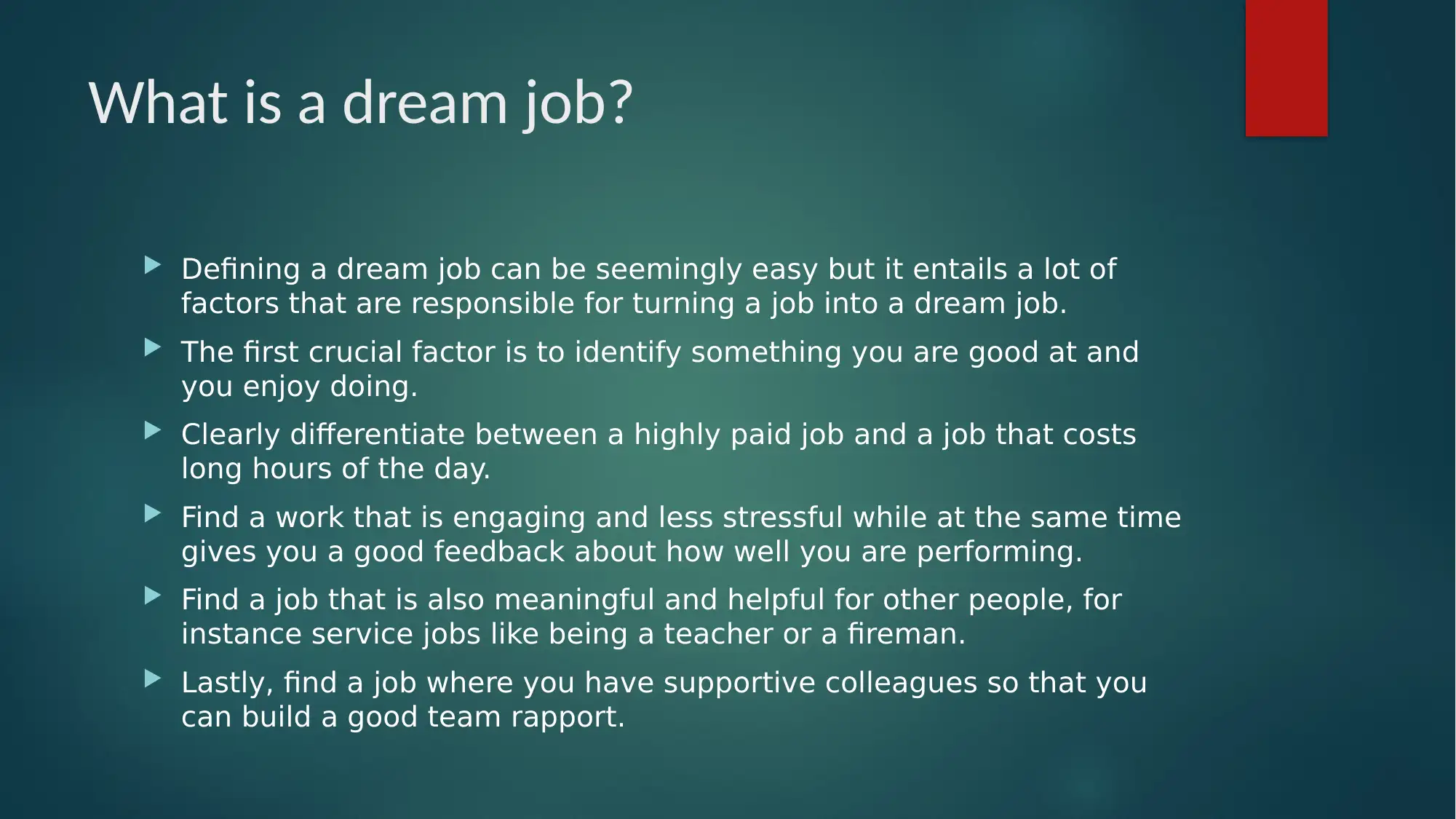
What is a dream job?
Defining a dream job can be seemingly easy but it entails a lot of
factors that are responsible for turning a job into a dream job.
The first crucial factor is to identify something you are good at and
you enjoy doing.
Clearly differentiate between a highly paid job and a job that costs
long hours of the day.
Find a work that is engaging and less stressful while at the same time
gives you a good feedback about how well you are performing.
Find a job that is also meaningful and helpful for other people, for
instance service jobs like being a teacher or a fireman.
Lastly, find a job where you have supportive colleagues so that you
can build a good team rapport.
Defining a dream job can be seemingly easy but it entails a lot of
factors that are responsible for turning a job into a dream job.
The first crucial factor is to identify something you are good at and
you enjoy doing.
Clearly differentiate between a highly paid job and a job that costs
long hours of the day.
Find a work that is engaging and less stressful while at the same time
gives you a good feedback about how well you are performing.
Find a job that is also meaningful and helpful for other people, for
instance service jobs like being a teacher or a fireman.
Lastly, find a job where you have supportive colleagues so that you
can build a good team rapport.
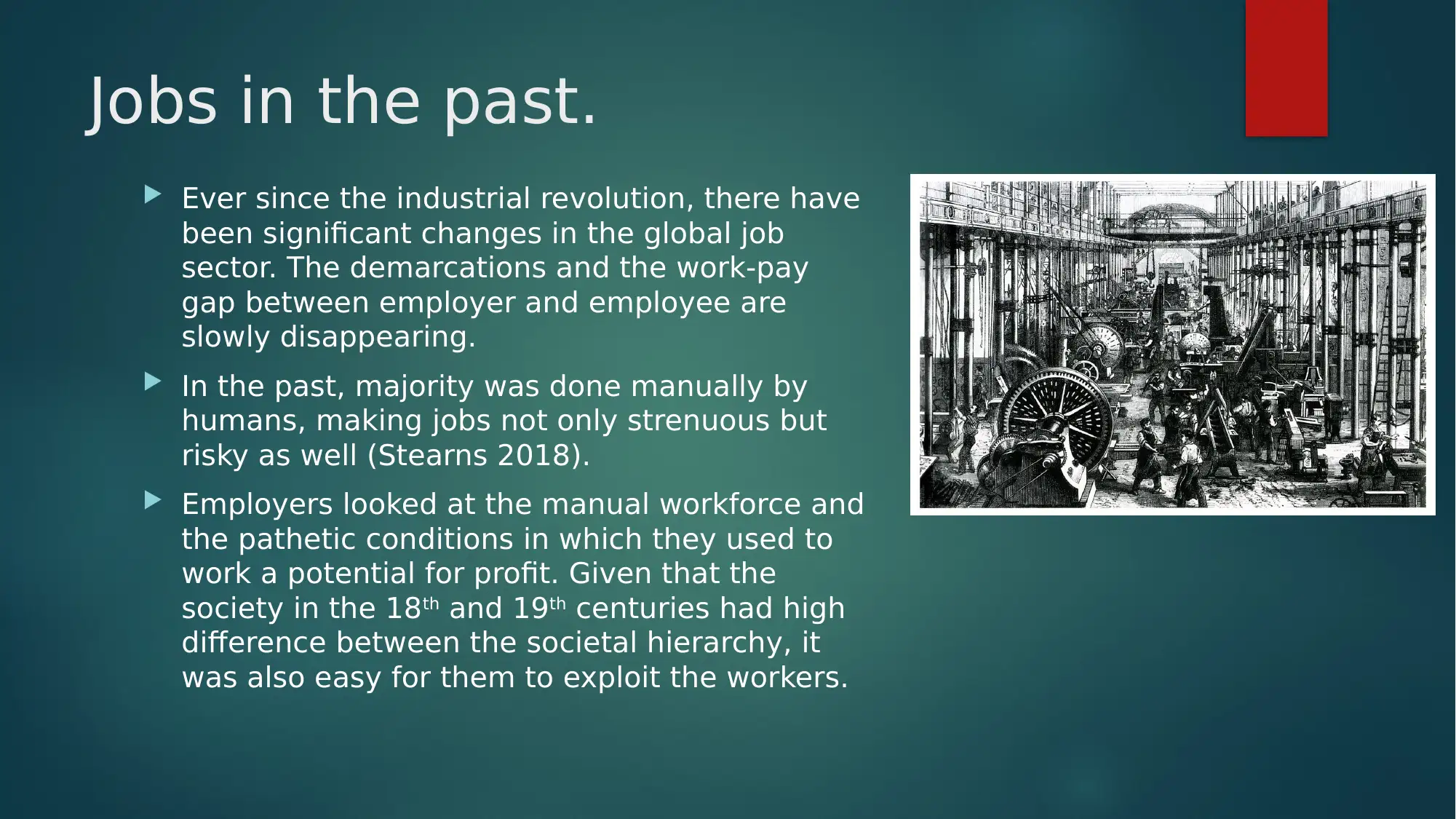
Jobs in the past.
Ever since the industrial revolution, there have
been significant changes in the global job
sector. The demarcations and the work-pay
gap between employer and employee are
slowly disappearing.
In the past, majority was done manually by
humans, making jobs not only strenuous but
risky as well (Stearns 2018).
Employers looked at the manual workforce and
the pathetic conditions in which they used to
work a potential for profit. Given that the
society in the 18th and 19th centuries had high
difference between the societal hierarchy, it
was also easy for them to exploit the workers.
Ever since the industrial revolution, there have
been significant changes in the global job
sector. The demarcations and the work-pay
gap between employer and employee are
slowly disappearing.
In the past, majority was done manually by
humans, making jobs not only strenuous but
risky as well (Stearns 2018).
Employers looked at the manual workforce and
the pathetic conditions in which they used to
work a potential for profit. Given that the
society in the 18th and 19th centuries had high
difference between the societal hierarchy, it
was also easy for them to exploit the workers.
⊘ This is a preview!⊘
Do you want full access?
Subscribe today to unlock all pages.

Trusted by 1+ million students worldwide
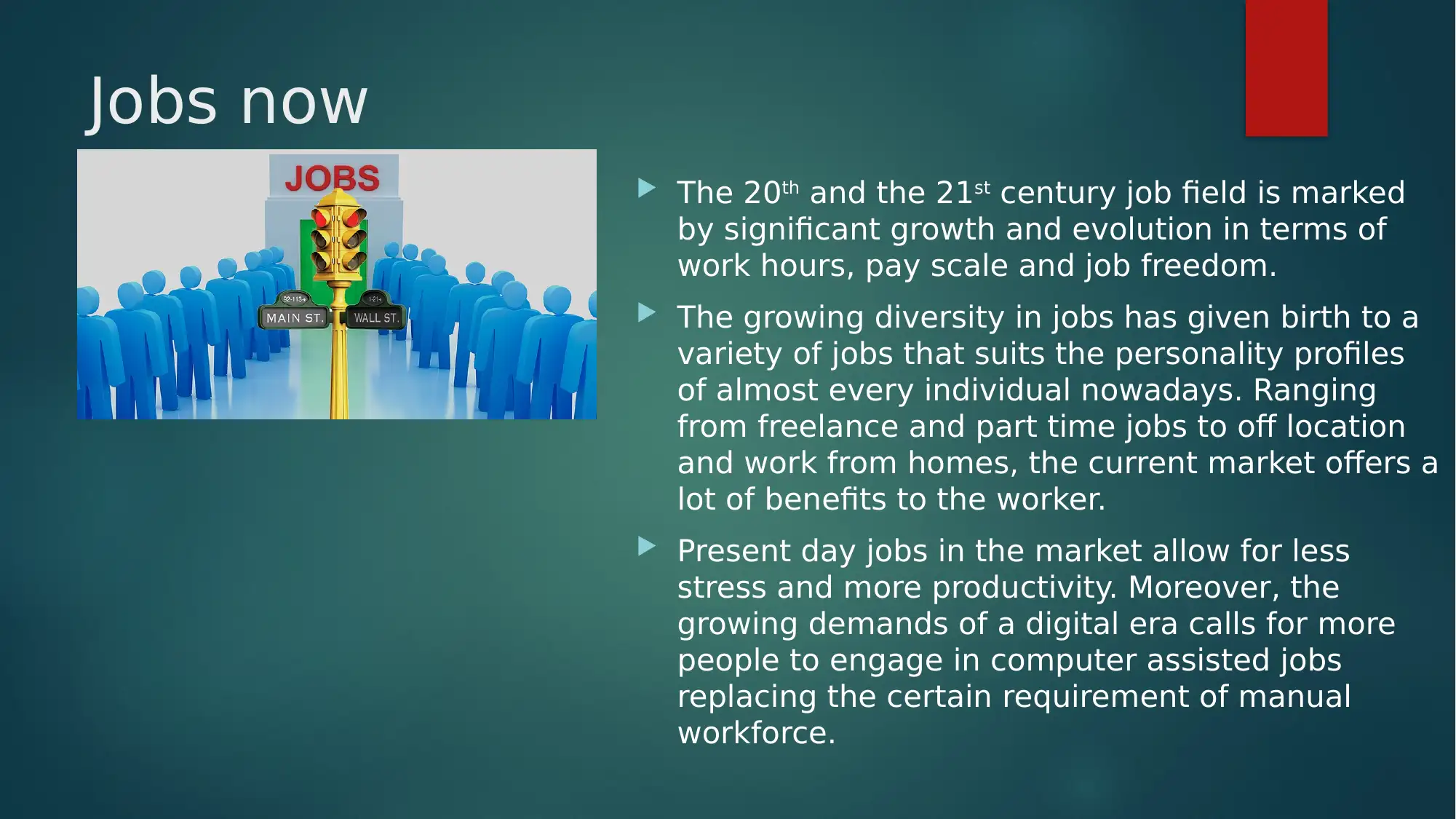
Jobs now
The 20th and the 21st century job field is marked
by significant growth and evolution in terms of
work hours, pay scale and job freedom.
The growing diversity in jobs has given birth to a
variety of jobs that suits the personality profiles
of almost every individual nowadays. Ranging
from freelance and part time jobs to off location
and work from homes, the current market offers a
lot of benefits to the worker.
Present day jobs in the market allow for less
stress and more productivity. Moreover, the
growing demands of a digital era calls for more
people to engage in computer assisted jobs
replacing the certain requirement of manual
workforce.
The 20th and the 21st century job field is marked
by significant growth and evolution in terms of
work hours, pay scale and job freedom.
The growing diversity in jobs has given birth to a
variety of jobs that suits the personality profiles
of almost every individual nowadays. Ranging
from freelance and part time jobs to off location
and work from homes, the current market offers a
lot of benefits to the worker.
Present day jobs in the market allow for less
stress and more productivity. Moreover, the
growing demands of a digital era calls for more
people to engage in computer assisted jobs
replacing the certain requirement of manual
workforce.
Paraphrase This Document
Need a fresh take? Get an instant paraphrase of this document with our AI Paraphraser
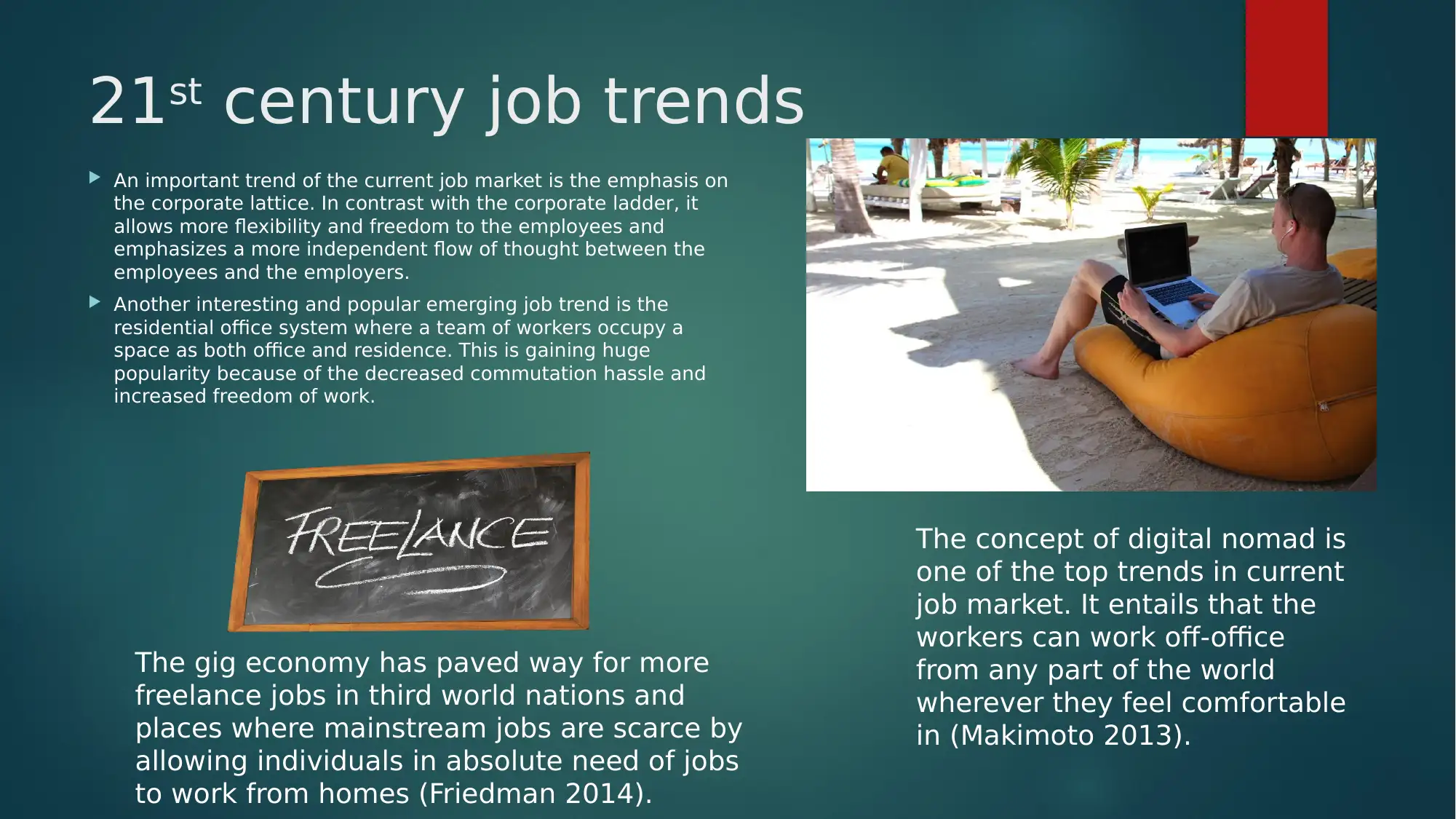
21st century job trends
An important trend of the current job market is the emphasis on
the corporate lattice. In contrast with the corporate ladder, it
allows more flexibility and freedom to the employees and
emphasizes a more independent flow of thought between the
employees and the employers.
Another interesting and popular emerging job trend is the
residential office system where a team of workers occupy a
space as both office and residence. This is gaining huge
popularity because of the decreased commutation hassle and
increased freedom of work.
The concept of digital nomad is
one of the top trends in current
job market. It entails that the
workers can work off-office
from any part of the world
wherever they feel comfortable
in (Makimoto 2013).
The gig economy has paved way for more
freelance jobs in third world nations and
places where mainstream jobs are scarce by
allowing individuals in absolute need of jobs
to work from homes (Friedman 2014).
An important trend of the current job market is the emphasis on
the corporate lattice. In contrast with the corporate ladder, it
allows more flexibility and freedom to the employees and
emphasizes a more independent flow of thought between the
employees and the employers.
Another interesting and popular emerging job trend is the
residential office system where a team of workers occupy a
space as both office and residence. This is gaining huge
popularity because of the decreased commutation hassle and
increased freedom of work.
The concept of digital nomad is
one of the top trends in current
job market. It entails that the
workers can work off-office
from any part of the world
wherever they feel comfortable
in (Makimoto 2013).
The gig economy has paved way for more
freelance jobs in third world nations and
places where mainstream jobs are scarce by
allowing individuals in absolute need of jobs
to work from homes (Friedman 2014).

Modern threats to modern jobs.
The vastness and diversity of work may have
proven to be beneficial for a lot of people but it
also has impacted a lot of jobs in a lot of different
ways.
The first threat to current jobs is the ethical
complication that entail a lot of corporate jobs –
monitoring (Yerby 2013).
A lot of companies have been reported to use
advanced monitoring technologies on their
employees for observing their working styles,
time, interaction with other colleagues etc
(Chang, Liu & Lin 2015).
The range of technologies used to monitor their
employees include display activity recorders to
bionic sensor-embedded tracking cards (Fine
2015).
Workplace monitoring has been
found to be a key aspect of
disinterest in a lot of employees
who, despite being in a job they
like doing, find the constant
surveillance by their bosses, intrusive
and disturbing (Frayne 2015).
The vastness and diversity of work may have
proven to be beneficial for a lot of people but it
also has impacted a lot of jobs in a lot of different
ways.
The first threat to current jobs is the ethical
complication that entail a lot of corporate jobs –
monitoring (Yerby 2013).
A lot of companies have been reported to use
advanced monitoring technologies on their
employees for observing their working styles,
time, interaction with other colleagues etc
(Chang, Liu & Lin 2015).
The range of technologies used to monitor their
employees include display activity recorders to
bionic sensor-embedded tracking cards (Fine
2015).
Workplace monitoring has been
found to be a key aspect of
disinterest in a lot of employees
who, despite being in a job they
like doing, find the constant
surveillance by their bosses, intrusive
and disturbing (Frayne 2015).
⊘ This is a preview!⊘
Do you want full access?
Subscribe today to unlock all pages.

Trusted by 1+ million students worldwide

The developers of these
monitoring technologies do not
work in collaboration with one
company but sell their products to
many companies worldwide
thereby making it difficult to
account for their claims of non –
intrusion. They also employ
deeply intricate algorithms for
their products to learn and evolve
on their own through the process
of deep learning, which brings us
to the next threat to modern jobs
– artificial intelligence.
Reports show that by 2030,
computers and robots would have
replaced 47% of the global
manual workforce (Fox &
O’Connor 2019).
Reports show that the
advent of advanced
robotics and artificial
intelligence has been a
matter of deep interest
in almost all major fields
of work (Graetz &
Michaels 2018).
However their
introduction has also
lessened the value of
human labour by a
significant amount
(Rotman 2013).
By 2025, as another study points out,
somewhere between 45 to 75 million
jobs could get severely affected and
even replaced by fully automated
artificial intelligence (Ilo.org, 2018).
monitoring technologies do not
work in collaboration with one
company but sell their products to
many companies worldwide
thereby making it difficult to
account for their claims of non –
intrusion. They also employ
deeply intricate algorithms for
their products to learn and evolve
on their own through the process
of deep learning, which brings us
to the next threat to modern jobs
– artificial intelligence.
Reports show that by 2030,
computers and robots would have
replaced 47% of the global
manual workforce (Fox &
O’Connor 2019).
Reports show that the
advent of advanced
robotics and artificial
intelligence has been a
matter of deep interest
in almost all major fields
of work (Graetz &
Michaels 2018).
However their
introduction has also
lessened the value of
human labour by a
significant amount
(Rotman 2013).
By 2025, as another study points out,
somewhere between 45 to 75 million
jobs could get severely affected and
even replaced by fully automated
artificial intelligence (Ilo.org, 2018).
Paraphrase This Document
Need a fresh take? Get an instant paraphrase of this document with our AI Paraphraser
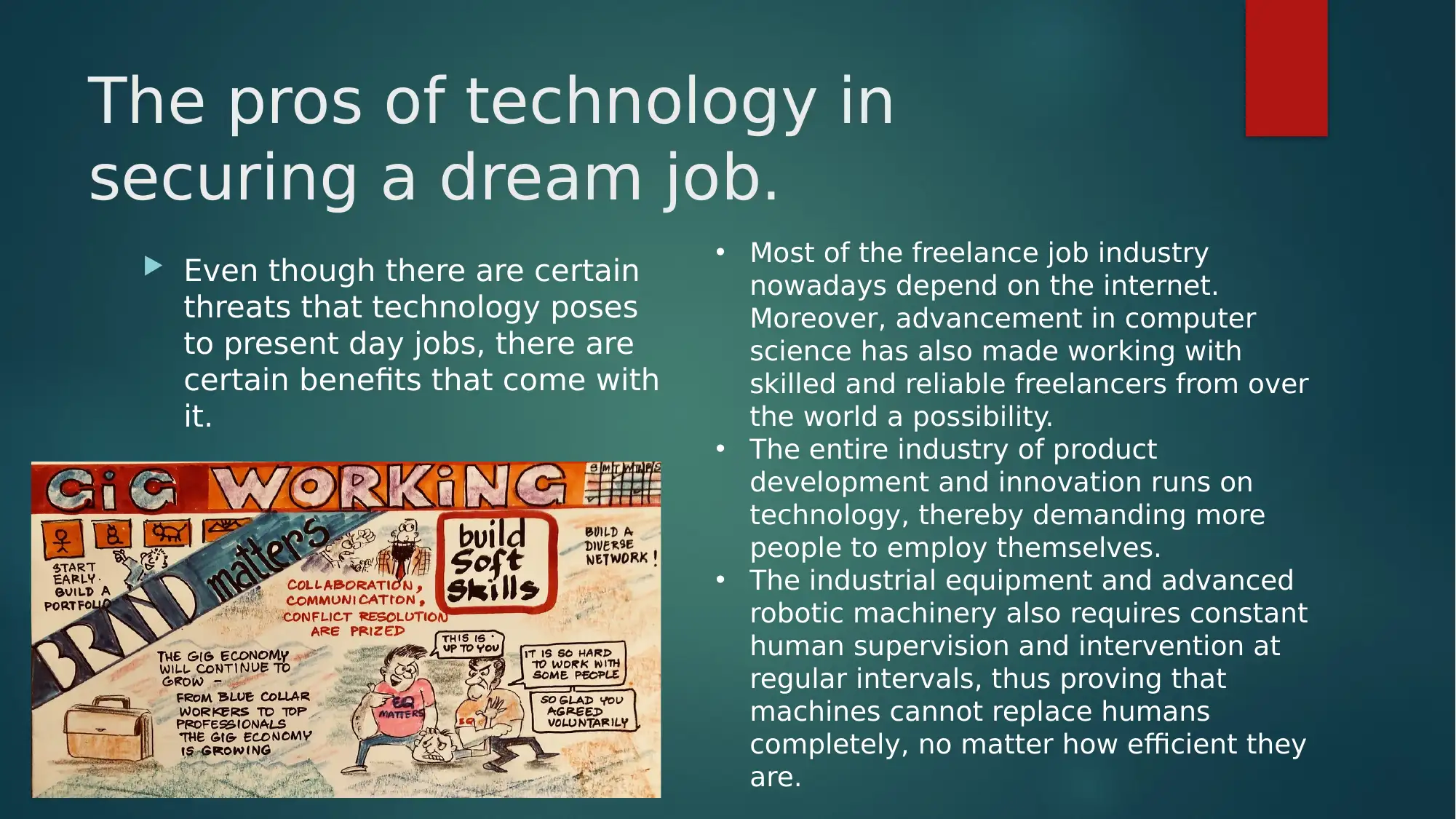
The pros of technology in
securing a dream job.
Even though there are certain
threats that technology poses
to present day jobs, there are
certain benefits that come with
it.
• Most of the freelance job industry
nowadays depend on the internet.
Moreover, advancement in computer
science has also made working with
skilled and reliable freelancers from over
the world a possibility.
• The entire industry of product
development and innovation runs on
technology, thereby demanding more
people to employ themselves.
• The industrial equipment and advanced
robotic machinery also requires constant
human supervision and intervention at
regular intervals, thus proving that
machines cannot replace humans
completely, no matter how efficient they
are.
securing a dream job.
Even though there are certain
threats that technology poses
to present day jobs, there are
certain benefits that come with
it.
• Most of the freelance job industry
nowadays depend on the internet.
Moreover, advancement in computer
science has also made working with
skilled and reliable freelancers from over
the world a possibility.
• The entire industry of product
development and innovation runs on
technology, thereby demanding more
people to employ themselves.
• The industrial equipment and advanced
robotic machinery also requires constant
human supervision and intervention at
regular intervals, thus proving that
machines cannot replace humans
completely, no matter how efficient they
are.

Even though advanced technology is seen as a potential threat to
the job market, there are studies that prove otherwise.
One of the studies point out that despite the possibility that
around 75 million jobs will be lost due to the advancement and
incorporation of machinery in human jobs, by 2022, 130 million
new jobs will be introduced (Is your job safe - collaboration,
automation, annihilation?, 2019).
The future of Jobs survey of 2018 reports that the top 5 trending
jobs by 2022 will be digital and tech based. The following list
shows the percentage increase of the top 5 jobs by 2022 (Centre
for the New Economy and Society 2018).
1. Big Data analysis (85%)
2. App and web enabled market (75%)
3. Internet of things (75%)
4. Machine Learning (73%)
5. Cloud Computing (72%)
the job market, there are studies that prove otherwise.
One of the studies point out that despite the possibility that
around 75 million jobs will be lost due to the advancement and
incorporation of machinery in human jobs, by 2022, 130 million
new jobs will be introduced (Is your job safe - collaboration,
automation, annihilation?, 2019).
The future of Jobs survey of 2018 reports that the top 5 trending
jobs by 2022 will be digital and tech based. The following list
shows the percentage increase of the top 5 jobs by 2022 (Centre
for the New Economy and Society 2018).
1. Big Data analysis (85%)
2. App and web enabled market (75%)
3. Internet of things (75%)
4. Machine Learning (73%)
5. Cloud Computing (72%)
⊘ This is a preview!⊘
Do you want full access?
Subscribe today to unlock all pages.

Trusted by 1+ million students worldwide
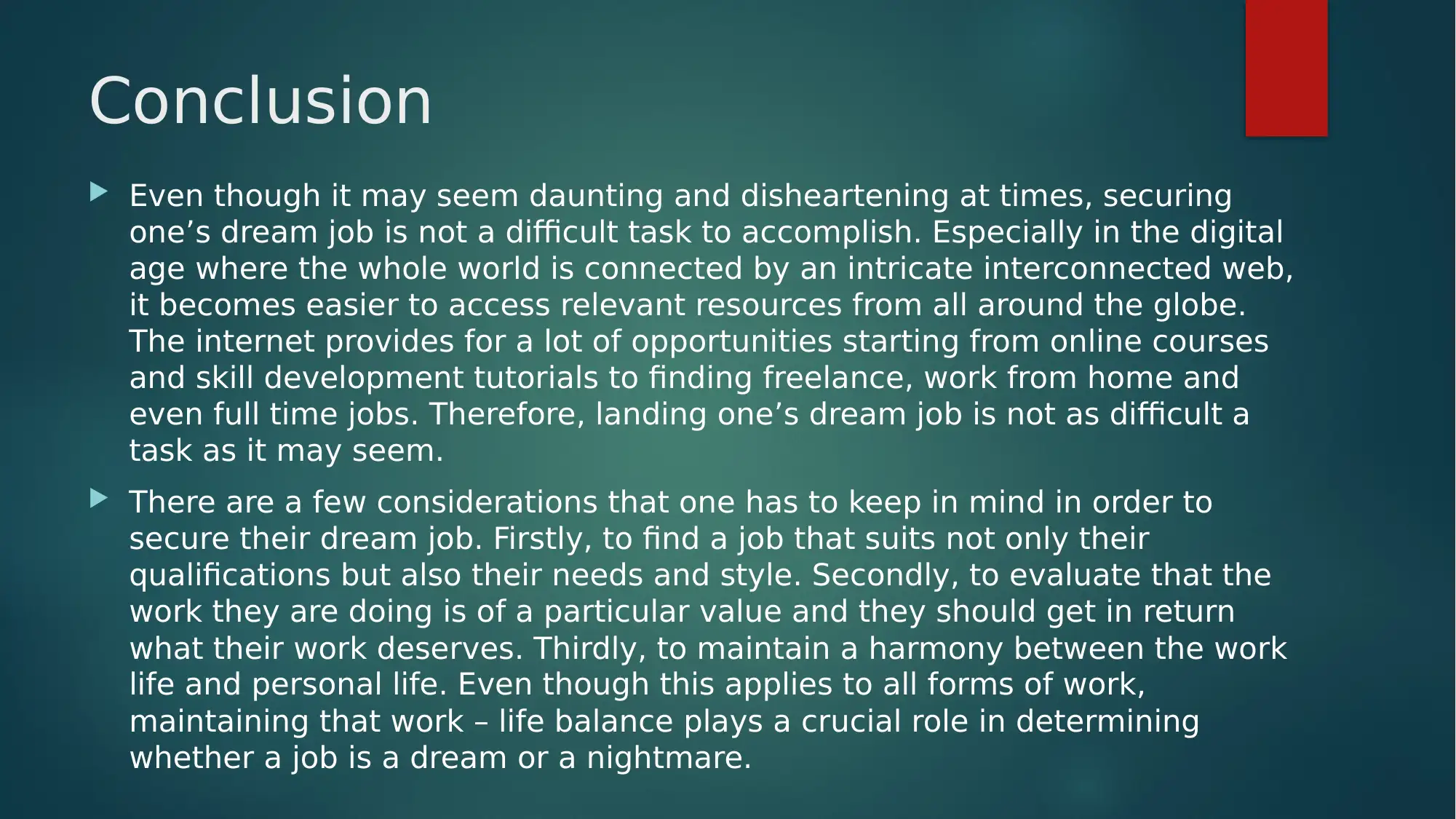
Conclusion
Even though it may seem daunting and disheartening at times, securing
one’s dream job is not a difficult task to accomplish. Especially in the digital
age where the whole world is connected by an intricate interconnected web,
it becomes easier to access relevant resources from all around the globe.
The internet provides for a lot of opportunities starting from online courses
and skill development tutorials to finding freelance, work from home and
even full time jobs. Therefore, landing one’s dream job is not as difficult a
task as it may seem.
There are a few considerations that one has to keep in mind in order to
secure their dream job. Firstly, to find a job that suits not only their
qualifications but also their needs and style. Secondly, to evaluate that the
work they are doing is of a particular value and they should get in return
what their work deserves. Thirdly, to maintain a harmony between the work
life and personal life. Even though this applies to all forms of work,
maintaining that work – life balance plays a crucial role in determining
whether a job is a dream or a nightmare.
Even though it may seem daunting and disheartening at times, securing
one’s dream job is not a difficult task to accomplish. Especially in the digital
age where the whole world is connected by an intricate interconnected web,
it becomes easier to access relevant resources from all around the globe.
The internet provides for a lot of opportunities starting from online courses
and skill development tutorials to finding freelance, work from home and
even full time jobs. Therefore, landing one’s dream job is not as difficult a
task as it may seem.
There are a few considerations that one has to keep in mind in order to
secure their dream job. Firstly, to find a job that suits not only their
qualifications but also their needs and style. Secondly, to evaluate that the
work they are doing is of a particular value and they should get in return
what their work deserves. Thirdly, to maintain a harmony between the work
life and personal life. Even though this applies to all forms of work,
maintaining that work – life balance plays a crucial role in determining
whether a job is a dream or a nightmare.
Paraphrase This Document
Need a fresh take? Get an instant paraphrase of this document with our AI Paraphraser
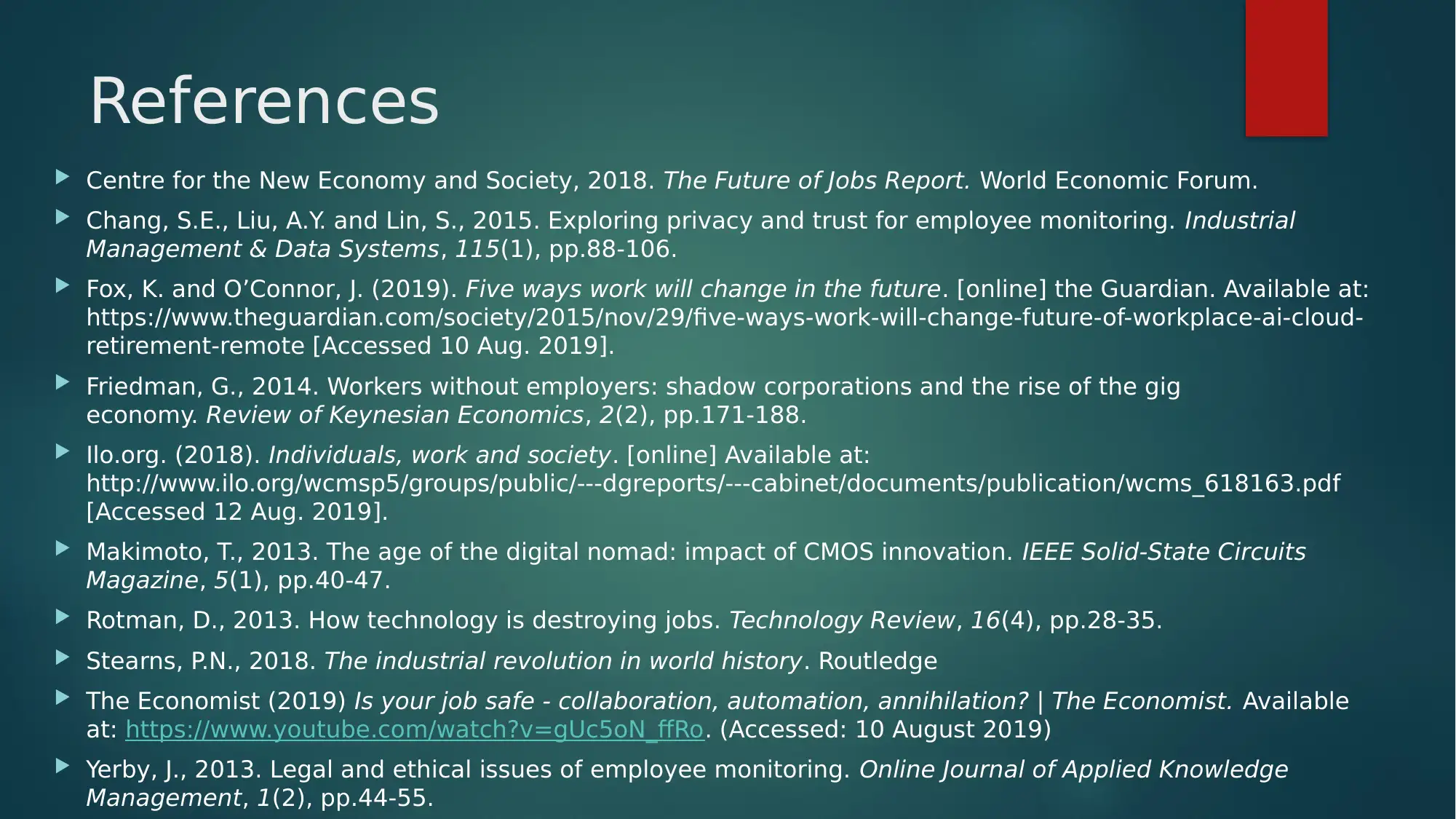
References
Centre for the New Economy and Society, 2018. The Future of Jobs Report. World Economic Forum.
Chang, S.E., Liu, A.Y. and Lin, S., 2015. Exploring privacy and trust for employee monitoring. Industrial
Management & Data Systems, 115(1), pp.88-106.
Fox, K. and O’Connor, J. (2019). Five ways work will change in the future. [online] the Guardian. Available at:
https://www.theguardian.com/society/2015/nov/29/five-ways-work-will-change-future-of-workplace-ai-cloud-
retirement-remote [Accessed 10 Aug. 2019].
Friedman, G., 2014. Workers without employers: shadow corporations and the rise of the gig
economy. Review of Keynesian Economics, 2(2), pp.171-188.
Ilo.org. (2018). Individuals, work and society. [online] Available at:
http://www.ilo.org/wcmsp5/groups/public/---dgreports/---cabinet/documents/publication/wcms_618163.pdf
[Accessed 12 Aug. 2019].
Makimoto, T., 2013. The age of the digital nomad: impact of CMOS innovation. IEEE Solid-State Circuits
Magazine, 5(1), pp.40-47.
Rotman, D., 2013. How technology is destroying jobs. Technology Review, 16(4), pp.28-35.
Stearns, P.N., 2018. The industrial revolution in world history. Routledge
The Economist (2019) Is your job safe - collaboration, automation, annihilation? | The Economist. Available
at: https://www.youtube.com/watch?v=gUc5oN_ffRo. (Accessed: 10 August 2019)
Yerby, J., 2013. Legal and ethical issues of employee monitoring. Online Journal of Applied Knowledge
Management, 1(2), pp.44-55.
Centre for the New Economy and Society, 2018. The Future of Jobs Report. World Economic Forum.
Chang, S.E., Liu, A.Y. and Lin, S., 2015. Exploring privacy and trust for employee monitoring. Industrial
Management & Data Systems, 115(1), pp.88-106.
Fox, K. and O’Connor, J. (2019). Five ways work will change in the future. [online] the Guardian. Available at:
https://www.theguardian.com/society/2015/nov/29/five-ways-work-will-change-future-of-workplace-ai-cloud-
retirement-remote [Accessed 10 Aug. 2019].
Friedman, G., 2014. Workers without employers: shadow corporations and the rise of the gig
economy. Review of Keynesian Economics, 2(2), pp.171-188.
Ilo.org. (2018). Individuals, work and society. [online] Available at:
http://www.ilo.org/wcmsp5/groups/public/---dgreports/---cabinet/documents/publication/wcms_618163.pdf
[Accessed 12 Aug. 2019].
Makimoto, T., 2013. The age of the digital nomad: impact of CMOS innovation. IEEE Solid-State Circuits
Magazine, 5(1), pp.40-47.
Rotman, D., 2013. How technology is destroying jobs. Technology Review, 16(4), pp.28-35.
Stearns, P.N., 2018. The industrial revolution in world history. Routledge
The Economist (2019) Is your job safe - collaboration, automation, annihilation? | The Economist. Available
at: https://www.youtube.com/watch?v=gUc5oN_ffRo. (Accessed: 10 August 2019)
Yerby, J., 2013. Legal and ethical issues of employee monitoring. Online Journal of Applied Knowledge
Management, 1(2), pp.44-55.
1 out of 11
Your All-in-One AI-Powered Toolkit for Academic Success.
+13062052269
info@desklib.com
Available 24*7 on WhatsApp / Email
![[object Object]](/_next/static/media/star-bottom.7253800d.svg)
Unlock your academic potential
Copyright © 2020–2025 A2Z Services. All Rights Reserved. Developed and managed by ZUCOL.


